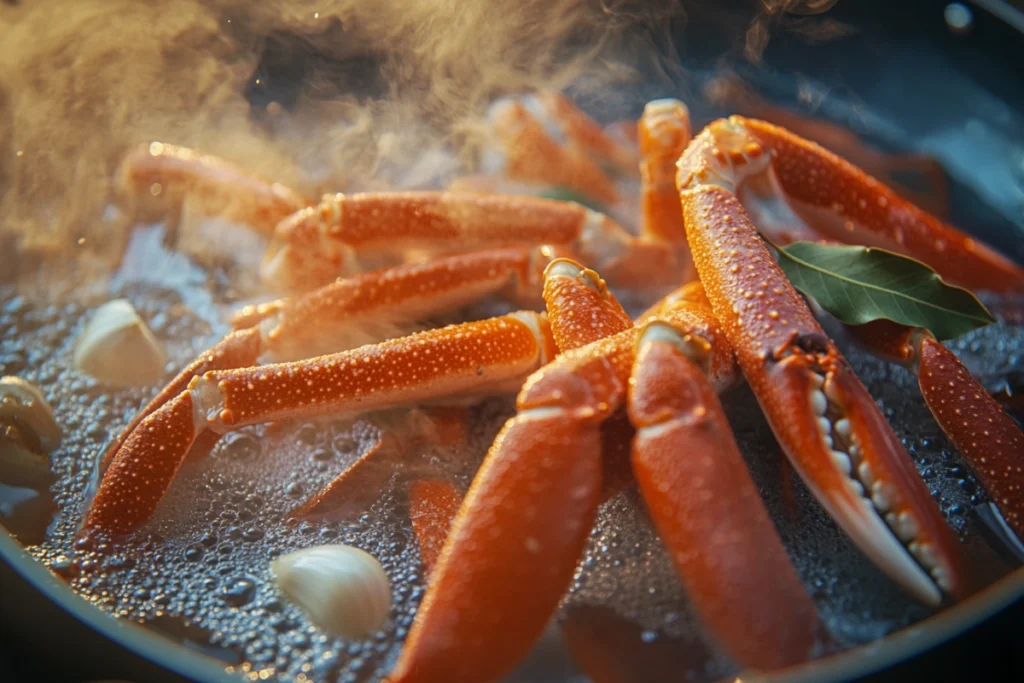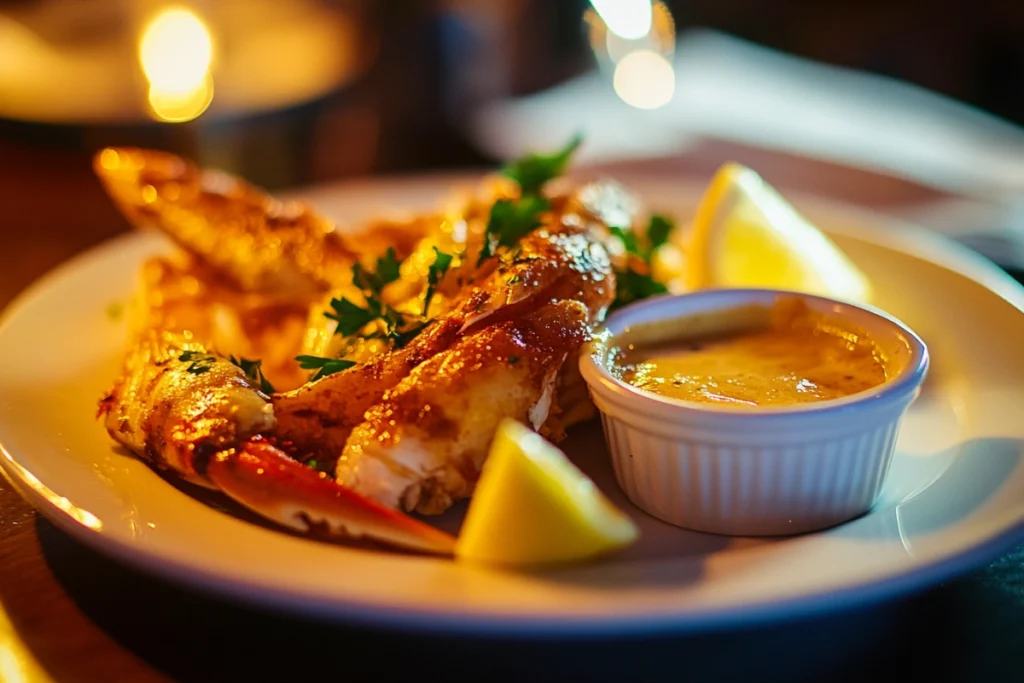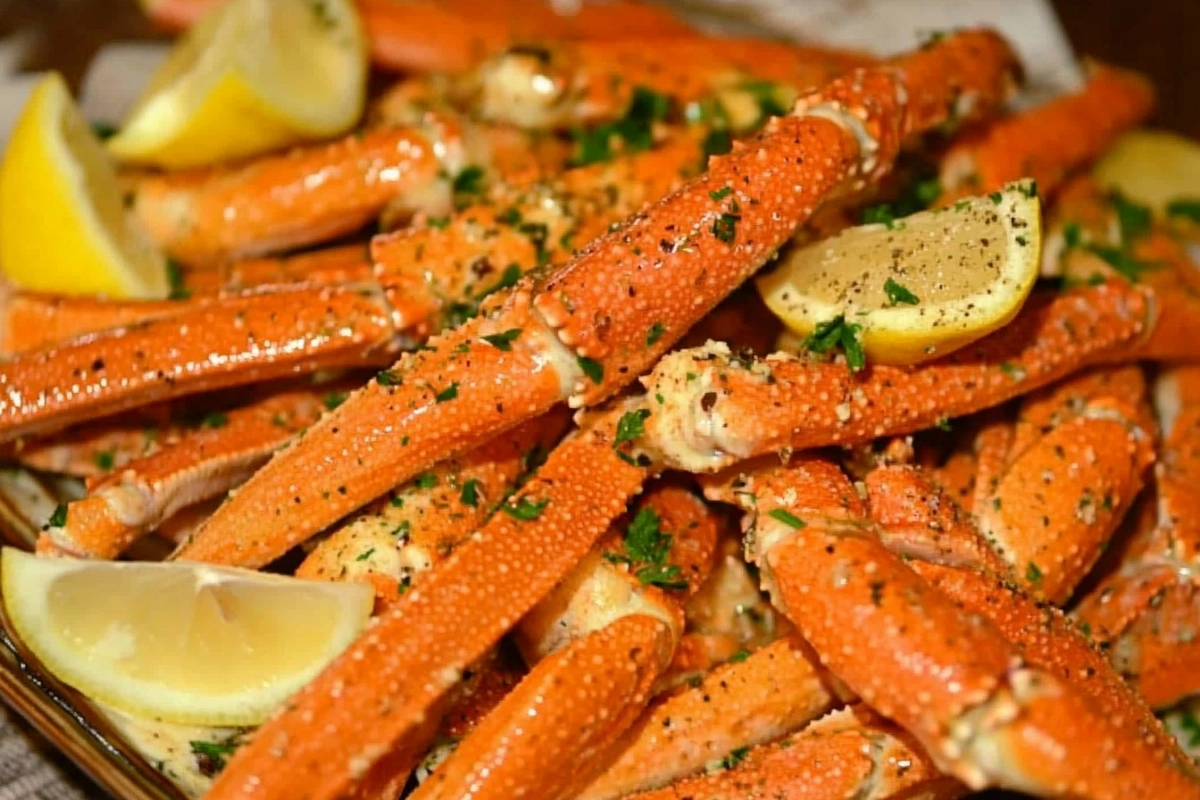Seafood lovers, get ready! If you’ve been craving a delicious seafood feast, snow crab legs are the perfect choice. Whether you’re planning a fancy dinner or just want a cozy night in with buttery crab meat, this guide covers everything you need to know about Fresh crab legs. From buying and storing to cooking and cracking, you’ll master it all here.
In this article, we’ll explore:
- What snow crab legs are and where they come from
- Their nutritional value and health benefits
- Step-by-step cooking methods
- Seasonings, sauces, and the best ways to serve them
By the end, you’ll be an expert in preparing and enjoying Fresh crab legs like a pro!
What Are Snow Crab Legs?
Snow crab legs are a delicacy prized for their sweet, tender meat and easy-to-crack shells. Often served in seafood boils or as a standalone treat, these crab legs make for a mouthwatering experience.
Introduction to Snow Crab Legs
Snow crab legs come from the snow crab, a species native to the cold waters of the North Atlantic and North Pacific oceans. Their long, slender legs are filled with succulent crab meat that boasts a mildly sweet flavor. The legs are often pre-cooked and flash-frozen right after harvesting to preserve their freshness.
Unlike other types of crab, Fresh crab legs are known for their easy-to-crack shells, making them a favorite for seafood platters and special occasions. They’re commonly sold in clusters, which include multiple legs and a portion of the body.
Snow Crab Species and Habitat
Snow crabs, scientifically known as Chionoecetes opilio, thrive in icy, deep waters where temperatures remain cold year-round. They are mostly found off the coasts of Alaska, Canada, and Russia, making them a staple in Alaskan seafood markets.
These crustaceans are harvested sustainably, with strict regulations in place to protect their populations. Snow crabs are prized not just for their taste but also for their large yields of crab meat, especially in the legs and claws.
Nutritional Value and Health Benefits of Snow Crab Legs
Snow crab legs aren’t just delicious—they’re also packed with essential nutrients that make them a healthy choice for seafood lovers. From protein to vital minerals, these legs can be a fantastic addition to a balanced diet.
Key Nutrients in Snow Crab Legs
Snow crab legs are rich in lean protein, making them perfect for those looking to build muscle or maintain a healthy weight. A single serving offers about 19 grams of protein while being relatively low in calories and fat.
They also provide a healthy dose of:
- Vitamin B12: Essential for brain health and nerve function
- Zinc and Copper: Boost immunity and aid metabolic functions
- Selenium: A powerful antioxidant supporting cell health
- Omega-3 Fatty Acids: Beneficial for heart health and reducing inflammation
Snow crab meat is also naturally low in carbohydrates, making it ideal for low-carb or keto diets.
Health Benefits of Eating Snow Crab Legs
Eating snow crab legs can deliver numerous health perks:
- Promotes Muscle Growth: The high protein content helps repair and build muscle tissue.
- Supports Heart Health: The presence of omega-3 fatty acids contributes to cardiovascular wellness.
- Aids Weight Management: Low in fat and carbs, Fresh crab legs can be part of a weight-loss diet.
- Boosts Immunity: Zinc and selenium help strengthen the immune system.
However, it’s worth noting that Fresh crab legs can be high in sodium, especially if pre-cooked and frozen. Enjoy them in moderation for optimal health benefits.
How to Buy and Store Snow Crab Legs
When selecting Frozen snow crab, quality matters. Here’s how to choose the freshest and store them properly for the best taste and texture.
Choosing Quality Snow Crab Legs
For the freshest experience, look for:
- Color: Fresh Fresh crab legs should be a pale pink or orange with no discoloration.
- Shell Integrity: Avoid legs with cracked or damaged shells.
- Odor: Quality crab legs should have a mild, ocean-like scent—not fishy.
When buying frozen, opt for legs without ice crystals, as this could indicate freezer burn or improper storage.
Proper Storage Techniques
To keep your King crab fresh:
- Refrigerator: Store fresh crab legs in the coldest part of the fridge and consume within 1-2 days.
- Freezer: If pre-cooked, keep them frozen at 0°F or below for up to 3 months.
- Thawing: Always thaw Fresh crab legs in the fridge overnight to retain their texture and flavor.
Following these steps ensures your Fresh crab legs stay tasty and safe to eat, whether you’re planning a seafood boil or a fancy dinner.
Different Methods to Cook Snow Crab Legs
Cooking Frozen snow crab at home is easier than you think! Whether you’re hosting a seafood feast or just craving a simple yet luxurious meal, there are several ways to prepare these delicious crustaceans. Here are the most popular methods for cooking Fresh crab legs, each enhancing their naturally sweet flavor.
Boiling Snow Crab Legs
Boiling is one of the quickest and most effective ways to cook Fresh crab legs. It preserves the meat’s tenderness while locking in moisture.
Steps to Boil Snow Crab Legs:
- Fill a large pot with water, adding a pinch of salt for extra flavor.
- Bring the water to a rolling boil.
- Submerge the crab legs and cook for 4-5 minutes if thawed or 8-10 minutes if frozen.
- Remove and drain. Serve with melted butter and lemon wedges.
Pro Tip: Add bay leaves and garlic cloves to the water for extra aroma.
Steaming Snow Crab Legs
Steaming is ideal for retaining the natural juices of the crab meat without diluting the flavor.
Steps to Steam Fresh crab legs:
- Add 2 inches of water to a pot and place a steaming basket inside.
- Heat the water until boiling.
- Place the crab legs in the basket, cover, and steam for 5-7 minutes.
This method works well for those preferring a milder taste, allowing the crab’s sweetness to shine.
Grilling Snow Crab Legs
Grilling adds a smoky twist to your Frozen snow crab, making them perfect for summer barbecues.
Steps to Grill Snow Crab Legs:
- Preheat the grill to medium heat.
- Lightly brush the crab legs with olive oil or butter.
- Grill for 5-7 minutes, turning occasionally.
The shells may char slightly, but this only enhances the flavor.
Baking Snow Crab Legs
Baking is a fuss-free option that’s perfect for large batches of Frozen snow crab.

Steps to Bake Snow Crab Legs:
- Preheat the oven to 375°F (190°C).
- Place the crab legs on a baking sheet and cover loosely with foil.
- Bake for 12-15 minutes until heated through.
Step-by-Step Guide to Boiling Snow Crab Legs
Boiling remains the most foolproof way to prepare Frozen snow crab. It’s fast, effective, and brings out the crab’s natural sweetness.
Ingredients and Tools Needed
- 2 pounds of snow crab legs (thawed or frozen)
- Large stockpot
- Salted water
- Optional: garlic cloves, bay leaves, lemon wedges
- Tongs for handling the crab
Step-by-Step Cooking Instructions
- Prepare the Pot: Fill a large stockpot with enough water to cover the Fresh crab legs. Add salt, garlic cloves, and bay leaves if desired.
- Bring to a Boil: Heat the water over high heat until it reaches a rolling boil.
- Add the Crab Legs: Carefully place the crab legs in the boiling water.
- Cooking Time: If thawed, cook for 4-5 minutes. If frozen, cook for 8-10 minutes.
- Drain and Serve: Remove the crab legs using tongs and let them drain briefly.
Serving Tip: Pair your boiled Frozen snow crab with melted butter, garlic butter sauce, or lemon wedges for the ultimate seafood experience.
For more mouthwatering seafood ideas, check out this Crab Brulee Recipe on Medium Recipes.
Seasonings and Sauces for Snow Crab Legs
Enhancing the natural sweetness of snow crab legs with the right seasonings and sauces can take your seafood feast to the next level. Whether you enjoy classic flavors or bold spices, the perfect pairing can make a world of difference.
Best Seasonings for Snow Crab Legs
While Frozen snow crab already have a mildly sweet taste, adding a sprinkle of spices can elevate the experience. Some of the best seasonings to complement crab meat include:
- Old Bay Seasoning: A classic seafood blend with celery salt, paprika, and mustard.
- Garlic Powder: Adds a rich, savory note without overpowering the crab’s sweetness.
- Lemon Pepper: Bright and zesty, perfect for balancing the richness of the butter.
- Cajun Seasoning: Ideal for those who enjoy a spicy kick with their crab legs.
- Fresh Herbs: Try parsley, dill, or chives for a subtle, refreshing touch.
To season effectively, sprinkle your chosen blend on the Frozen snow crab before cooking or toss them in melted butter infused with herbs after boiling or steaming.
Top Dipping Sauces for Snow Crab Legs
Dipping sauces can turn a simple plate of snow crab legs into a gourmet delight. Here are some favorites:
- Garlic Butter Sauce: Melt butter with minced garlic for a rich, decadent dip.
- Classic Lemon Butter: Melted butter mixed with freshly squeezed lemon juice.
- Spicy Cajun Dip: Blend melted butter with Cajun spices and a dash of hot sauce.
- Herb Butter Sauce: Butter infused with fresh herbs like dill, thyme, and rosemary.
Pro Tip: Serve multiple sauces so guests can mix and match flavors with their Frozen snow crab.
How to Eat Snow Crab Legs
Eating Crab legs recipe can be fun and rewarding once you know the right technique. Follow these steps to make the most of your seafood experience without wasting any delicious meat.
Cracking Techniques
The shells of Frozen snow crab are thinner than those of king crabs, making them easier to crack. Here’s how to do it:
- Snap at the Joint: Bend the crab leg at each joint. The meat often slides out effortlessly.
- Use Kitchen Shears: If needed, cut along the length of the leg shell for easy access.
- Crack the Claw: Use a crab cracker or gently tap with the back of a knife to break the claw open.
Avoid excessive force to prevent shell fragments from mixing with the meat.
Extracting the Meat Properly
To get the most meat from your Frozen snow crab:
- Gently pull the meat out using a seafood fork or your fingers.
- Dip the meat into your chosen sauce for maximum flavor.
- Discard the shells and enjoy the sweet, tender crab meat.
Pro Tip: Pair your Crab legs recipe with side dishes like corn on the cob, garlic bread, or a light coleslaw for a full seafood feast.
Snow Crab Legs vs. Other Crab Varieties
Crabs come in various types, each with its own taste, texture, and culinary appeal. While Fresh crab legs are a popular choice, it’s helpful to compare them with other well-known crab varieties to better understand their unique qualities.
Snow Crab vs. King Crab
Snow crab legs and king crab legs are both seafood delicacies, but they differ in several ways:
- Size: King crab legs are much larger, often reaching over a foot in length, while Frozen snow crab are smaller and more manageable.
- Shell Thickness: King crab shells are thicker and spikier, requiring more effort to crack compared to the thinner, easier-to-crack shells of Fresh crab legs.
- Flavor: Fresh crab legs offer a sweeter, more delicate taste, while king crab meat is richer and slightly briny.
- Price: King crab tends to be more expensive due to its size and limited availability.
Fresh crab legs are ideal for casual seafood dinners, while king crab makes a statement for special occasions.
Snow Crab vs. Dungeness Crab
Dungeness crab is another seafood favorite, but it differs significantly from Crab legs recipe:
- Meat Texture: Dungeness crab meat is softer and slightly more fibrous than the firmer meat found in Fresh crab legs.
- Cooking Style: Dungeness crabs are often served whole, while Frozen snow crab are typically sold pre-cooked and separated.
- Taste: Both types of crab offer sweet, mild meat, but Frozen snow crab tend to have a more delicate flavor.
When choosing between them, consider whether you prefer the convenience of pre-cooked legs or the traditional experience of cracking a whole crab.
Popular Recipes Using Snow Crab Legs
Ready to get creative with sCrab legs recipe? These recipes showcase their sweet, tender meat in delicious ways that are perfect for any seafood lover.
Garlic Butter Snow Crab Legs Recipe

Garlic butter Frozen snow crab are a crowd-pleasing favorite and surprisingly easy to make.
Ingredients:
- 2 pounds of King crab (thawed)
- 1/2 cup unsalted butter
- 4 garlic cloves, minced
- 1 tablespoon lemon juice
- Fresh parsley for garnish
Instructions:
- Melt butter in a saucepan over medium heat.
- Add minced garlic and cook until fragrant.
- Stir in lemon juice and remove from heat.
- Boil or steam the Fresh crab legs as previously instructed.
- Brush the crab legs with the garlic butter or serve as a dip.
- Garnish with parsley and enjoy!
Snow Crab Legs with Lemon Herb Butter
For a lighter twist, try Frozen snow crab with lemon herb butter.
Ingredients:
- 2 pounds Crab meat
- 1/2 cup butter
- Zest of one lemon
- 1 tablespoon lemon juice
- Fresh dill and chives, finely chopped
Instructions:
- Melt butter and mix in lemon zest, juice, dill, and chives.
- Cook the Fresh crab legs using your preferred method.
- Serve the crab legs with the lemon herb butter as a dip or drizzle it directly on top.
Nutritional Value of Snow Crab Legs (Per 100g)
Below is the nutritional content of Fresh crab legs :
| Nutrient | Amount |
|---|---|
| Calories | 90 kcal |
| Protein | 19g |
| Total Fat | 1.2g |
| Carbohydrates | 0g |
| Sodium | 836mg |
| Cholesterol | 55mg |
| Vitamin B12 | 11mcg |
| Calcium | 55mg |
| Iron | 0.5mg |
These values make Crab legs recipe a nutritious choice, packed with protein and essential vitamins while being low in fat and carbs.

